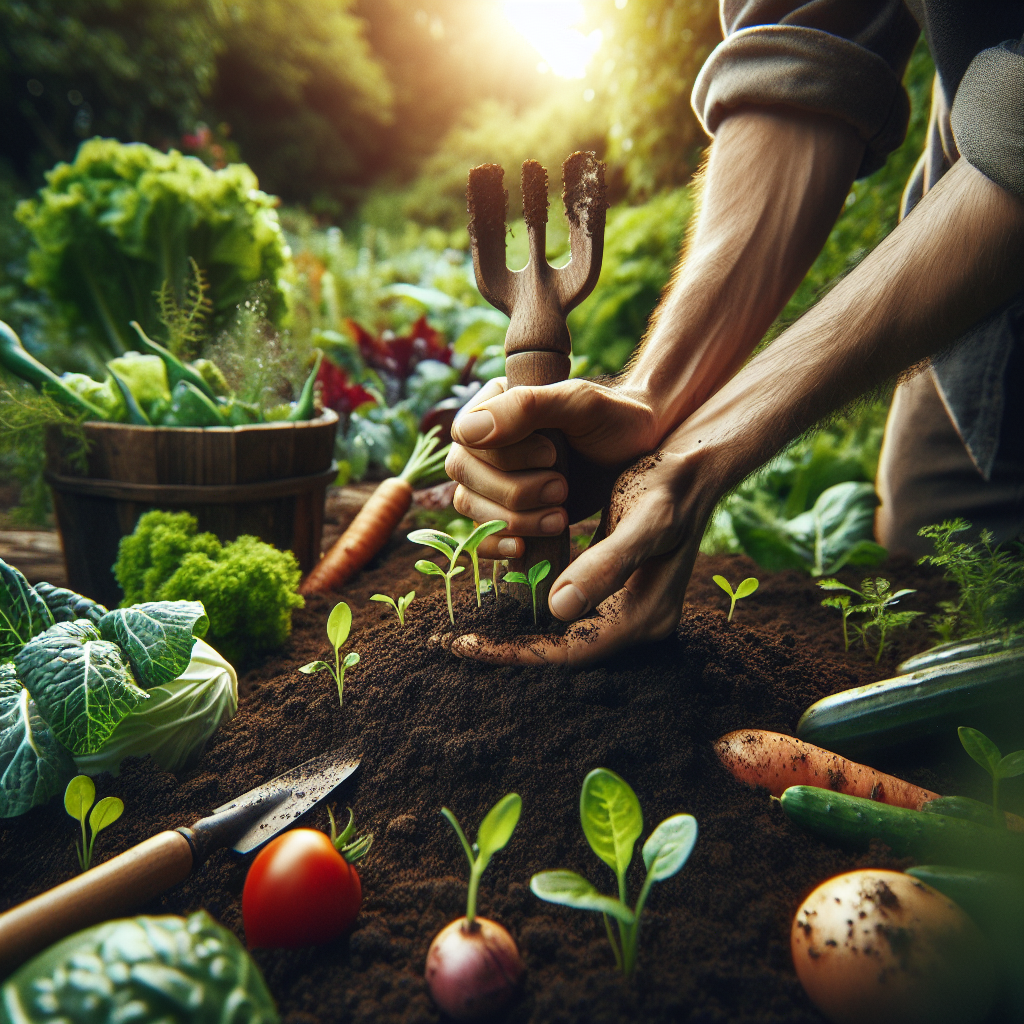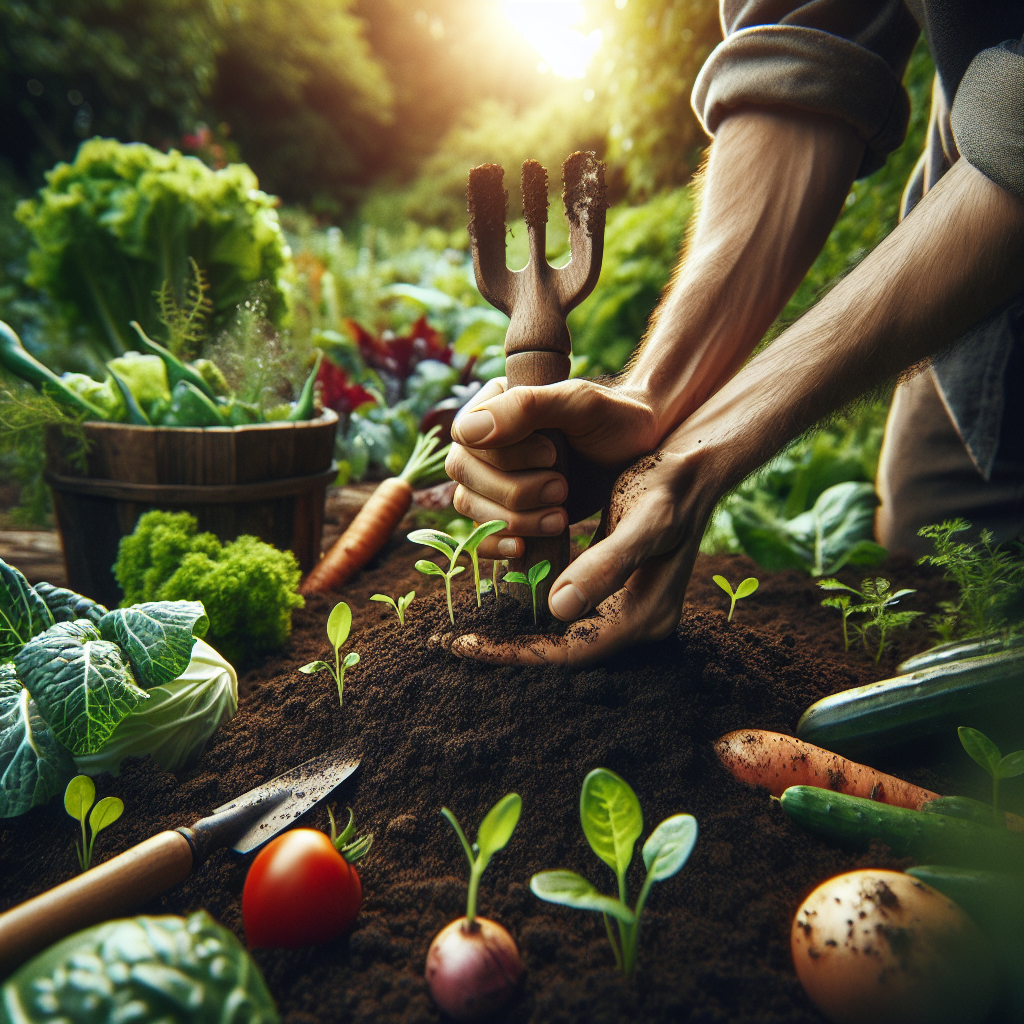Are you tired of buying vegetables with unknown origins and potentially harmful chemicals? Look no further, because this article has got you covered! In this guide, we will explore the fascinating world of growing your own organic vegetables. From selecting the right seeds to nurturing your plants, we will walk you through every step of the process. Get ready to embark on a journey of self-sustainability and healthier, tastier produce. Let’s dig in and discover the joys of cultivating your very own garden!

Choosing the Right Location
Consider Sun Exposure
When choosing a location for your organic vegetable garden, it’s important to consider the amount of sun exposure that area receives. Most vegetables require at least six hours of direct sunlight each day to grow and thrive. Take note of the areas in your yard that receive the most sun throughout the day and choose a location that provides adequate sunlight for your plants.
Evaluate Soil Quality
The quality of the soil in your chosen location is crucial for the success of your organic vegetable garden. Conduct a soil test to determine its pH level and nutrient content. Most vegetables prefer a slightly acidic soil with a pH range of 6.0 to 7.0. Depending on the results of your soil test, you may need to amend the soil by adding organic matter or adjusting the pH level to create optimal growing conditions for your vegetables.
Assess Drainage Conditions
Proper drainage is essential for the health of your vegetable plants. Choose a location that doesn’t retain standing water after rainfall or irrigation. Excess moisture in the soil can lead to root rot and other diseases. If your chosen location has poor drainage, consider implementing raised beds or improving the soil structure to ensure adequate water drainage.
Determine Space Availability
Consider the available space in your garden when choosing a location. Different vegetables require varying amounts of space to grow properly. Some plants, such as tomatoes and cucumbers, need ample room for their sprawling vines, while others, like lettuce and herbs, can be planted closer together. Plan your garden layout accordingly to optimize space usage and maximize your vegetable yield.
Selecting Organic Seeds
Understand Organic Seed Standards
Before purchasing organic seeds, familiarize yourself with the standards and regulations that define organic seed production. Organic seeds are produced without the use of synthetic chemicals or genetically modified organisms (GMOs). Look for certified organic seed varieties that meet these standards and are labeled as such.
Identify Reliable Seed Suppliers
When selecting organic seeds, it’s crucial to choose reputable and reliable seed suppliers. Look for suppliers who specialize in organic seeds and have a good reputation within the gardening community. You can also seek recommendations from fellow organic gardeners or consult online gardening forums for advice on trusted seed suppliers.
Consider Seed Viability
Seed viability refers to the ability of seeds to germinate and grow into healthy plants. Before purchasing your organic seeds, check the seed packet or supplier’s information to determine the seed’s viability. Some seeds may have a shorter shelf life, so it’s essential to select seeds that have a high germination rate to ensure successful plant growth.
Choose Vegetable Varieties
When selecting organic seeds, consider the vegetable varieties that best suit your preferences and growing conditions. Take into account factors such as climate, available space, and personal taste preferences. Some vegetables are more suited for specific regions or may require certain growing conditions to thrive. Choose a variety of vegetables that will provide a diverse and abundant harvest from your organic garden.
Preparing the Soil
Clear the Area
Before preparing your soil, clear the designated area of any vegetation, including weeds and grass. Use a lawnmower, weed trimmer, or manually remove the unwanted plants from the area. Clearing the area ensures that your vegetable plants won’t have to compete with existing weeds or grass for nutrients and resources.
Remove Weeds and Grass
After clearing the area, it’s essential to remove any remaining weeds or grass. These unwanted plants can compete with your vegetable plants for nutrients, water, and sunlight. Use a garden hoe, hand tool, or manually pull out the weeds at their roots to eradicate them effectively. Removing weeds and grass helps create a clean and weed-free environment for your vegetable plants to grow.
Test Soil pH and Nutrients
Testing your soil’s pH level and nutrient content is a crucial step in preparing your organic vegetable garden. You can use a soil testing kit or send a sample to a reputable soil testing laboratory. The results will guide you in making necessary soil amendments to achieve the ideal pH level and nutrient balance for optimal plant growth. Adding organic matter, such as compost or well-aged manure, can help improve the soil quality and fertility.
Add Compost and Organic Matter
To enrich and improve the soil structure, it’s beneficial to add compost and organic matter. Compost provides essential nutrients, improves soil moisture retention, and enhances microbial activity. Spread a layer of compost and organic matter over the prepared soil and use a garden fork or tiller to incorporate it thoroughly. This will create a nutrient-rich and well-draining soil environment for your organic vegetables to thrive.

Planning the Garden Layout
Consider Companion Planting
Companion planting is the practice of strategically placing plants that benefit each other in close proximity. By incorporating companion planting in your garden layout, you can promote healthier growth, repel pests, and improve pollination. For example, planting marigolds near tomatoes can help deter harmful insects, while planting basil near peppers can enhance their flavor. Research companion planting techniques for your chosen vegetable varieties to maximize their potential.
Determine Plant Spacing
Each vegetable variety has specific spacing requirements to ensure proper growth and development. It’s crucial to consider the mature size of your plants when planning your garden layout. Plants that are placed too closely together can compete for resources, stunt growth, and hinder air circulation, leading to increased disease susceptibility. Refer to seed packets or gardening references to determine the appropriate spacing for your vegetable plants.
Design Efficient Pathways
Incorporating efficient pathways in your garden layout makes it easier to navigate and perform necessary maintenance tasks, such as watering, weeding, and harvesting. Plan the pathways in a way that allows you to access all areas of your garden without stepping on or compacting the soil around your plants. Consider using materials such as mulch, gravel, or stepping stones to define and maintain your garden pathways.
Include Vertical Gardening
Vertical gardening is an excellent technique for maximizing space utilization in your organic vegetable garden. By growing certain vegetables vertically, you can save valuable garden space and increase your overall yield. Options for vertical gardening include trellises, arbors, or cages for vining plants like tomatoes and cucumbers. Incorporating vertical gardening techniques adds height and visual interest to your garden while promoting better air circulation and easier harvesting.
Planting Your Organic Vegetables
Follow Planting Instructions
When it’s time to plant your organic vegetables, it’s essential to follow the specific planting instructions for each variety. Seed packets or supplier information typically provide guidelines on planting depth, spacing, and recommended planting dates. Adhering to these instructions ensures that your plants have the best possible start and increases their chances of successful growth.
Water the Seedlings Properly
After planting, it’s crucial to provide adequate water to nourish the newly planted seedlings. Watering the seedlings gently and evenly helps settle the soil, promotes root establishment, and relieves any stress caused by the transplanting process. Use a watering can, hose with a gentle spray nozzle, or drip irrigation system to deliver a consistent amount of water to your organic vegetable plants.
Consider Using Seed Trays
Seed trays, also known as seedling flats or seedling trays, can be a useful tool for starting your organic vegetables from seeds indoors. These trays provide a controlled environment for seed germination and early plant growth. They can help maintain consistent moisture levels, protect seedlings from extreme temperatures, and make the transplanting process easier. Consider using seed trays to give your organic vegetables a head start before transferring them to the garden.
Implement Succession Planting
Succession planting involves planting new crops in stages to ensure a continuous harvest throughout the growing season. By staggering your plantings, you can extend the harvest period and prevent an overwhelming abundance of vegetables all at once. Determine the appropriate timing for each vegetable variety and plant additional seeds or seedlings at regular intervals. Succession planting allows for a more manageable and consistent supply of fresh organic vegetables.
Providing Adequate Water
Understand Watering Needs
Water is a vital component in the growth and development of your organic vegetables. Understanding the watering needs of different vegetable varieties is essential for maintaining their health and productivity. Some vegetables, such as leafy greens, have higher water requirements and may need frequent watering, while others, like root crops, require less frequent watering. Research the specific watering needs of your chosen vegetables to ensure they receive the right amount of moisture.
Irrigate Deeply and Infrequently
When watering your organic vegetable garden, it’s crucial to ensure deep root penetration and avoid shallow watering that only dampens the topsoil. Deep, infrequent watering encourages the plants to develop deep and robust root systems, making them more resilient and able to withstand dry periods. Use techniques such as slow drip irrigation or soaker hoses to provide a deep and thorough watering to your vegetables.
Avoid Overwatering
While it’s important to provide adequate water, overwatering can be detrimental to your organic vegetable plants. Excessive moisture in the soil can lead to oxygen deprivation, root rot, and the proliferation of fungal diseases. Monitor the soil moisture level by checking the top few inches of soil with your finger. Water only when the soil feels dry to the touch. Maintaining a balance between adequate moisture and proper drainage is crucial for the overall health of your plants.
Consider Drip Irrigation Systems
Drip irrigation is an efficient and water-conserving method for watering your organic vegetable garden. It delivers water directly to the plants’ root zones, minimizing water loss through evaporation or runoff. Drip irrigation systems utilize porous hoses or tubing with built-in emitters that release water slowly and evenly. This method not only conserves water but also reduces the risk of foliar diseases by keeping the foliage dry.
Managing Organic Pest Control
Identify Common Garden Pests
Part of successfully growing organic vegetables is being able to identify and manage common garden pests. Common pests include aphids, snails, slugs, caterpillars, and beetles. Regularly inspect your plants for signs of damage or the presence of pests. By identifying pests early, you can take appropriate measures to prevent an infestation and minimize damage to your organic vegetable garden.
Implement Integrated Pest Management
Integrated Pest Management (IPM) is a holistic approach to managing garden pests that emphasizes prevention and uses a combination of natural strategies to maintain a balanced ecosystem. Instead of relying solely on chemical pesticides, IPM encourages practices like planting pest-resistant varieties, attracting beneficial insects, and using physical barriers to deter pests. Implementing IPM techniques helps maintain the health and biodiversity of your garden while minimizing pest damage.
Encourage Beneficial Insects
Creating a welcoming environment for beneficial insects is an effective and natural way to manage garden pests. Ladybugs, lacewings, and hoverflies are examples of beneficial insects that feed on harmful pests like aphids and caterpillars. Planting flowers, such as yarrow, daisies, or marigolds, can attract these beneficial insects to your garden. Providing a diverse and pesticide-free habitat helps establish a balanced ecosystem and reduces the need for chemical pest control methods.
Use Organic Pest Control Methods
When faced with a pest infestation, consider organic pest control methods to minimize the use of synthetic chemicals. Organic pesticides derived from natural ingredients, such as neem oil, insecticidal soap, or mineral-based products, can effectively control pests while being less harmful to beneficial insects, pollinators, and the environment. Follow product instructions carefully and apply organic pest control methods sparingly and strategically to protect your organic vegetable plants.
Organic Weed Management
Implement Mulching Techniques
Mulching is an essential weed management technique in organic vegetable gardening. It involves covering the soil surface around your plants with a layer of organic matter, such as straw, wood chips, or compost. Mulch suppresses weed growth by blocking sunlight and depriving weeds of the conditions they need to germinate and grow. It also helps retain soil moisture, regulate soil temperature, and improve soil structure as it decomposes.
Handpick Weeds Regularly
Regularly inspect your organic vegetable garden and handpick any weeds that make their way into your growing beds. Handpicking weeds is a simple and effective method to prevent them from competing with your vegetable plants for nutrients and resources. Before they have a chance to spread and establish deep roots, remove weeds by gently pulling them out at the base. Consistent and timely weed removal reduces the likelihood of weed infestations and reduces the need for chemical weed control.
Use Organic Weed Killers
In some cases, handpicking and mulching may not be sufficient to control persistent or invasive weeds. Organic weed killers, made from natural ingredients like vinegar or citric acid, can be an option for spot treatment of particularly stubborn weeds. These products should be used sparingly and carefully to avoid damage to desirable plants. Always follow the instructions on the product label and prioritize organic weed management methods whenever possible.
Apply Good Crop Rotation
Crop rotation is an effective technique to manage weeds and reduce soil-borne diseases in your organic vegetable garden. Avoid planting the same vegetable family in the same area year after year, as this can create ideal conditions for pests and diseases to thrive. By rotating crops, you disrupt the life cycles of weeds and pests, reducing their impact on your organic vegetables. Plan your crop rotations in advance, considering the different plant families and their specific growth requirements.
Caring for Your Vegetable Plants
Provide Adequate Nutrients
Proper nutrition is essential for the healthy growth and productivity of your organic vegetable plants. Organic fertilizers, such as compost, aged manure, or seaweed-based products, can help provide the necessary nutrients your plants need. Apply organic fertilizers according to package instructions or amend the soil with compost before planting. Regularly monitor your plants for signs of nutrient deficiencies and adjust your feeding schedule or fertilization methods accordingly.
Monitor for Plant Diseases
Monitoring your organic vegetable plants for signs of diseases is crucial for early detection and prompt intervention. Watch for symptoms like stunted growth, yellowing leaves, wilting, or the presence of mold or fungus. Some common plant diseases in organic vegetable gardens include powdery mildew, bacterial spot, and blight. Proper crop rotation, good airflow, and maintaining overall plant health through organic gardening practices can help minimize the risk of diseases.
Implement Crop Rotation
In addition to managing weeds and pests, crop rotation also helps prevent the build-up of soil-borne diseases. Rotating plant families from one growing season to the next interrupts disease cycles and reduces the risk of infections. Plan your crop rotations carefully, considering the compatibility of different plants and their nutrient requirements. Maintaining a diverse crop rotation not only benefits your organic vegetables but also improves overall soil health.
Support Plants with Stakes or Trellises
Certain vegetable varieties, such as tomatoes, peas, and cucumbers, benefit from additional support as they grow. Providing stakes, trellises, or cages helps keep the plants upright, improves air circulation, and reduces the risk of disease. This support also makes it easier to harvest your organic vegetables and prevents damage to the plants from being in contact with the ground. Install stakes or trellises before planting or once the plants have established and need support.
Harvesting and Storing Organic Vegetables
Determine Harvest Time
Knowing when to harvest your organic vegetables is crucial to ensure peak flavor, texture, and nutritional value. Each vegetable variety has specific indicators of ripeness, such as color, size, or firmness. Refer to seed packets, gardening references, or online resources to determine the ideal harvesting time for your chosen vegetables. Harvesting too early or too late can result in a subpar taste or texture, so it’s important to monitor your plants closely.
Follow Proper Harvesting Techniques
When harvesting your organic vegetables, use appropriate tools, such as garden shears or a sharp knife, to avoid damaging the plants. For leafy greens, harvest the outer leaves first, allowing the inner leaves to continue growing. For fruits and vegetables like tomatoes or peppers, gently twist or cut them from the plant when they are fully ripe. Treat your harvested organic vegetables with care to minimize bruising or damage.
Clean and Store Vegetables
After harvesting, it’s essential to clean your organic vegetables to remove any dirt, insects, or debris. Rinse them gently with water and pat them dry before storing. Some vegetables, such as root crops or green beans, may require trimming or washing more thoroughly. Proper cleaning helps maintain the quality and prolongs the shelf life of your freshly harvested organic vegetables.
Utilize Food Preservation Methods
To enjoy the bounty of your organic vegetable garden for an extended period, consider utilizing food preservation methods. Options such as canning, freezing, pickling, or dehydrating allow you to store the surplus harvest for later use. Each preservation method has its own requirements, so follow established recipes and guidelines for safe and effective food preservation. Preserving your organic vegetables ensures you can enjoy them throughout the year and reduce food waste.
In conclusion, growing your own organic vegetables requires careful planning and attention to various factors such as location, seed selection, soil preparation, garden layout, and proper care practices. By following the guidelines outlined in this comprehensive article, you can create a thriving organic vegetable garden that not only provides you with nutritious and delicious produce but also promotes sustainability and a closer connection to nature. Happy gardening!

